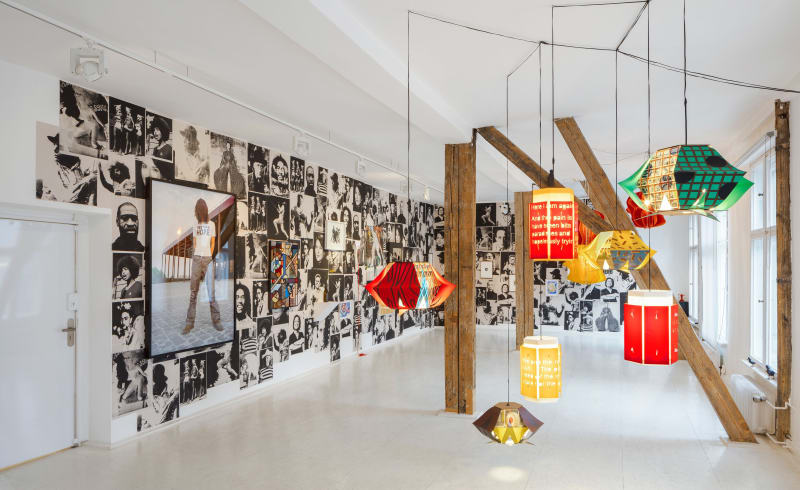Green Go Home: Tomas Vu & Rirkrit Tiravanija
with works by Saâdane Afif, Nevin Aladağ, Julieta Aranda, Nigin Beck, Monica Bonvicini, Rafael Domenech, Eliza Douglas, Cecilia Granara, Elizabeth Jaeger, Tony Just, Šejla Kamerić, Fabian Knecht, Daniel Knorr, Zoë Claire Miller, Jorge Pardo, Anri Sala, Alvaro Urbano, Danh Vō, Raphaela Vogel, Peter Welz and Jonas Wendelin.
Hua International is pleased to present the Berlin edition of Green Go Home, a collaborative project initiated by the internationally acclaimed artists Tomas Vu and Rirkrit Tiravanija.
Green Go Home continually modifies its mediums, manifesting differently each time that it occupies a new landscape. Conceived as a form of dynamic dialogue with the looming protests and civil unrest throughout the world today, this context-responsive undertaking brings together found images and evocative text that equally recall the fragmented language of self-actualization found on many social media platforms and the poetic, agit-prop of historical movements like the Situationist International. In the imagery itself, revolutionaries like Angela Davis rub shoulders with pop cultural figures such as David Bowie, Tupac Shakur, and Barbarella, or artists Frida Kahlo and Ana Mendieta, and scenes from films or a found photo of a historic beauty pageant. The grid of images takes on a polyphonic relationship to Tiravanija’s written statement, thereby interweaving layers of interpretation, readings, and misunderstandings.
With a conceptually- and socially-engaged artistic practice that intersects with notions related to place, care, and collaboration, Tiravanija’s works often seeks to build bridges and foster relationships between local collaborators. “Home,” he claims, “is where we are more inspired, we function better, we have our stories, our memories, our politics and our real relationships.” In the Berlin iteration of Green Go Home, the works of twelve Berlin-based artists take center stage, ranging from subtle personal interventions to more politically-charged contributions that directly react to local politics. Vu and Tiravanija have invited local artists they admire, both long-term colleagues and strangers, ranging from emerging artists to those with internationally-established careers. The walls of Green Go Home in Berlin are wheat pasted with Vu and Tiravanija’s silk screened “figures” on newsprint, quite literally providing a wallpaper for the invited artists to exhibit their work upon.
Like a modern-day Angelus Novus, an anonymous figure stands in front of the Nantes Courthouse in Saâdane Afif’s photograph Restore Hope, their tousled hair completely obscuring their face. The slogan on the person’s t-shirt reappropriates the name of the US Army’s over-mediated intervention in Somalia in 1992/93 playing upon the instrumentalization of hope in contemporary political discourse. In her series Social Fabric, Nevin Aladag “constructs” colorful composite landscapes from carpets of various formats and origins. Julieta Aranda’s 54H – SURVIVABILITY asks related to “counterintuitive empathy,” examining how urban spaces have been affected by hostility through the metaphor of the spider web. Nigin Beck’s sculpture explores the tropes and myths around love, loss, and nostalgia, straining each sweeping thematic through two disparate cultures that are informed by her own heritage. Monica Bonvicini contributes a disarmingly simple drawing entitled The Thrill is Gone. The title refers to a well-known song played in the jazz circle since the 30s, from both male and female musicians, among the most recognized versions is by B. B. King. Bonvicini's works often uses language as the starting point for sculptures or installations. Using song lyrics or quotations from literature and poetry, she edits a new narrative full of references. Here Bonvicini refers to the version played by the avant-garde composer Diamanda Galas, whose interpretation is full of darkness and violent female desire that she appropriates with feminist and punk aesthetic. Rafael Domenech’s lamps entitled Syndrome of Movement (Poems, Poster) fragment the authority of the author and text to give birth to a reader in movement, who navigates the space between image and text to construct a narrative of infinite possibility. Eliza Douglas has generated a significant body of appropriations of the American painter Josh Smith, blowing up elements of the work to banner-sized or shrinking them into small, jewel-like compositions. For Green Go Home, Douglas presents a new painting: a portrait of Smith himself in front of one of his massive works.
Cecilia Granara uses painting as a metalanguage to celebrate states of inner consciousness—mental and emotional—which are in constant flux. This dynamism is projected into her canvasses through an informal handling of outlines, taking possession of the highest and most ecstatic sense of figuration. Although Tony Just’s works have the physical appearance of paintings they are equally recording an action or dynamic event on canvas – documents of a gesture in the truest sense. Despite a seeming familiarity with the figurativeness of Elizabeth Jaeger’s objects, there is a sense of disquiet and subtle uncanniness inherent in her work that challenges the viewer’s relationship to their own physicality, their surrounding and their consciousness. The all-pervading element in Šejla Kamerić’s work are her, often uneasy, memories, which she uses as a power source by sharpening the focus of the present through the burden of the past. In “UNVERÄNDERUNG” (Unchange), Fabian Knecht examines how problematic and politically far-reaching the interpretation of temperature can be in the discourse around climate change. Daniel Knorr brings a silver optimism with the new work Depression Elevations Berlin Wall Nugget, No. 60, in which a small piece of the Berlin Wall covered in layers of day glow high chroma color floats glowing in a vitrine on the wall. As a sculptor, Zoë Claire Miller primarily works with ceramics and is particularly concerned with questions of collaboration, objecthood, and negative space. A symbol of the struggle for the right to self-determination over one’s own body, her work Reproductive Justice is a ceramic in the shape of a womb whose ovaries hold two scales. The piece René am Hermi revolves around the productive potential of anger as a politicized emotion. It refers specifically to the highly contested luxury development plan for the Karstadt building at Hermannplatz, for which real estate mogul René Benko's company SIGNA has invested in elaborate lobbying and PR efforts, which are met with broad resistance from the locals. Through their appearance, manufacture and the context in which they are displayed, Jorge Pardo’s lamps enjoy a dual, and potentially ambiguous status, as artwork and as functional design objects.
Anri Sala’s drawing Them Apples (Save/Besira) emerged from a three-day workshop with refugees in the Berlin district of Moabit, after which each participant selected the drawing they liked the best. As writer Martin Herbert notes, “Beyond the associations with knowledge, both of these processes—choosing and putting one’s own unique imprint on the fruit—are concerned with individuation: ‘refugee’ is a generalisation that clouds uniqueness and, potentially, blocks empathy.” Lies (Yellow), Alvaro Urbano’s sculpture of a single wilting rose tricks the eye with its striking verisimilitude, prompting us to reflect upon how the beautiful and romantic necessarily entails traces of deception. Danh Vō has contributed a photogravure, entitled 01.08.1945, which depicts a small-scale replica of the Statue of Liberty atop a Buddhist temple in Hanoi. The date of the title refers to the toppling and melting of the statue because of its association with French Colonialism, which speaks to the current moment (and its complications) around the world where public monuments are being toppled in a frenzy to decolonize public spaces. Raphaela Vogel’s art exists in a physically palpable tension and in a richly contrasting interplay between imagination and scale. Powerful and energetic spaces evolve, bringing into focus issues pertaining to human, especially female, subjectivity. Jonas Wendelin’s multi-disciplinary approach is often centered around technological evolution, social organization, and the expansiveness of communication. Through the cutouts in his work still | cut out | AA Bronson | John Giorno, Peter Welz breaks with the illusionism of photography and instead makes the materiality of the medium visible, questioning the flatness of the canvas and investigating its spatial and sculptural potential.










